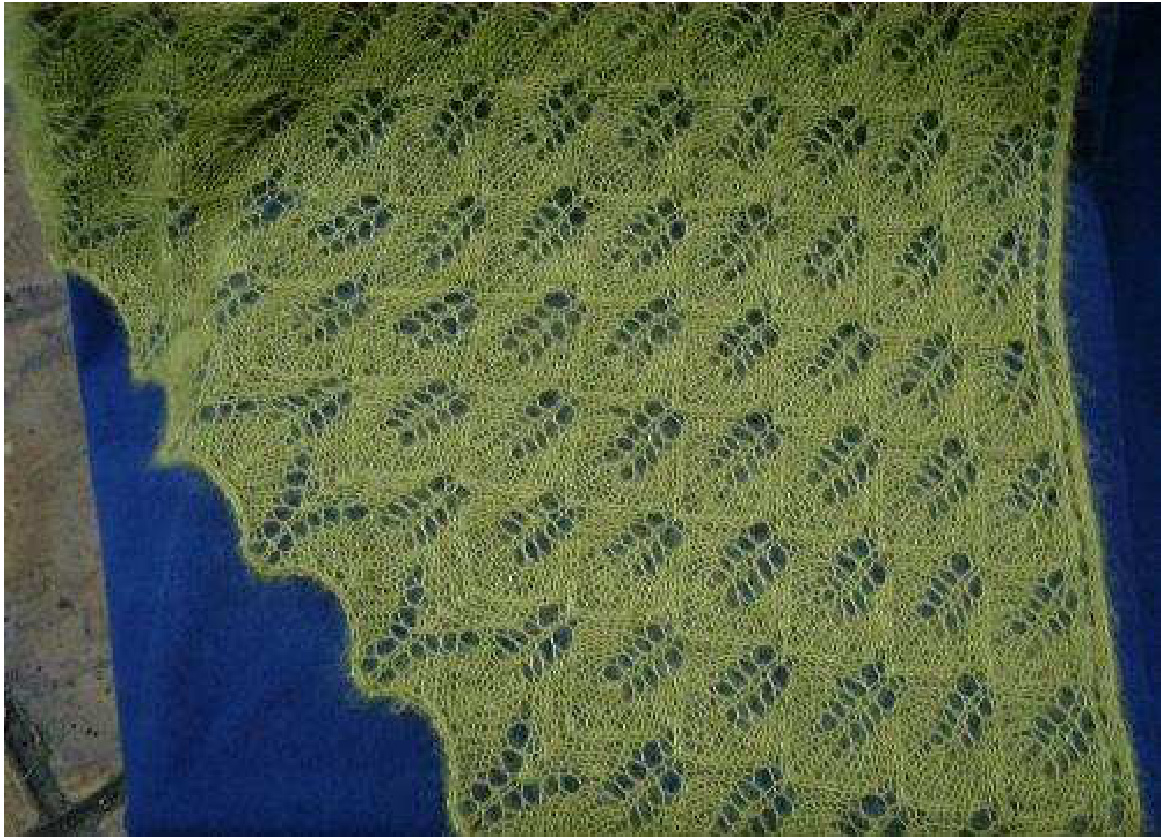Finished Measurements (blocked) 77in x 36in/196cm x 91cm
Material 3 balls Rowan Kid Silk Haze 210m/25g in Jelly Needles used: 4.5 mm circular, 5.0mm circular
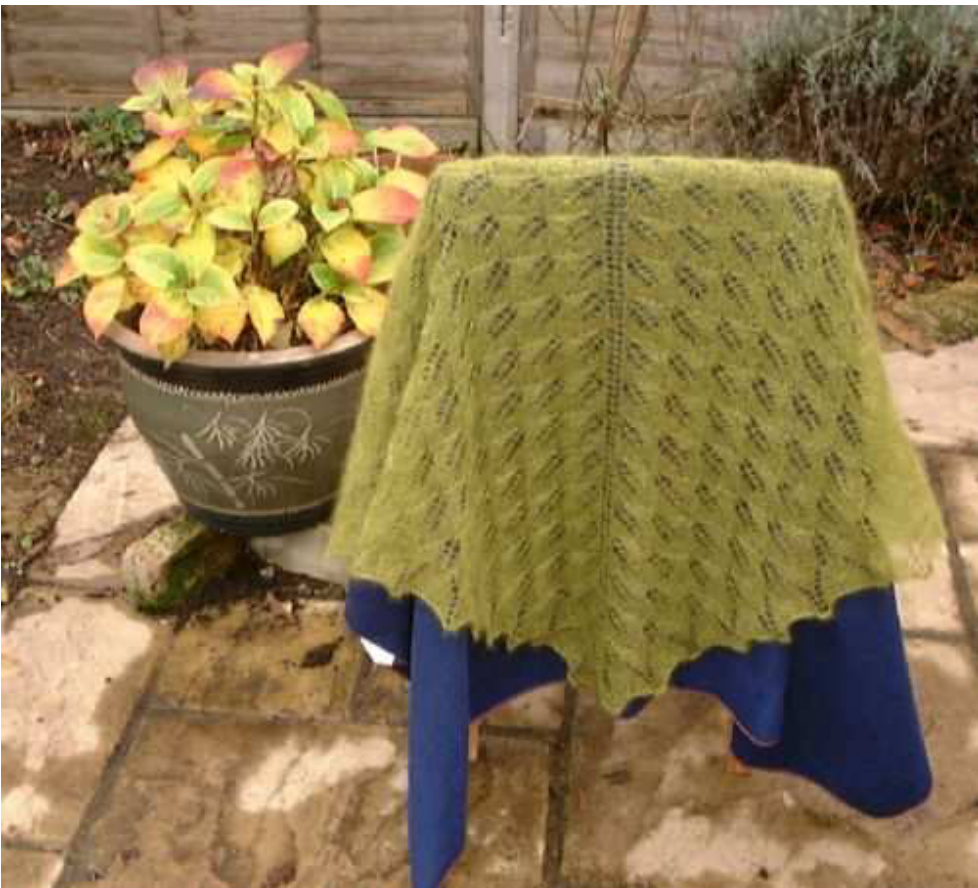
2 stitch markers 1 tapestry needle length of waste yarn (about 8 inches long), blocking pins
Gauge
Not important, as long as you like the density of the fabric after blocking. Kiri is a triangular shawl, with fern motif, garter stitch border and scalloped edging. Knit in Rowan Kid Silk haze, it has a gossamer effect which belies its warmth. The pattern uses 3 balls of Kid Silk Haze. At 75 grams, it's the perfect shawl to wear throughout theyear The Fern motif is a classic Shetland motif that works well either on its own or as a panel within a larger design. I have adapted the original design used by Sharon Miller in her Birch shawl for Rowan, to make the pattern easier for new lace knitters. I used techniques that I have learned from knitting the Fiber Trends designs by Evelyn Clark. This pattern contains charts and written instructions. If you're put off by Birch, which requires casting on a lot of stitches and decreasing to the point, then try this version. Worked from the neck down, it uses a common increasing technique to create the point for a triangular shawl. You can work until you get the length/width that I did, or until you get bored with the pattern. As the shawl is worked from the neck down, the tension is not as important as getting the fabric that you like. You can easily knit this on heavier or finer yarns. If you are using Kid silk haze, and find yourself running short, buy more yarn. Kid Silk Haze is a nightmare to rip. Theshawl abovewasmadewith3ballsof Rowan Kid Silk Haze on 4.5mm needles.All measurements and details provided for this pattern are based on this yarn. This project took me approx 24 hours to complete. Special thanks, to Carol Wessel, for helping me to name this design and Debbie of Larry & Debbie and Margie for errata on edging.
Tips
1. Don't be too optimistic. When you get towards the bottom of the shawl, you will need a lot more yarn that you think to complete a row. It took me nearly a full ball of yarn for complete the edging + 1.5 repeat. 2. To join KSH, just overlap the ends and work 5-6 stitches. The yarn is so hairy that you'll probably not be able to find the end to trim. 3. Kid Silk Haze soaked for 20minutes is like dragging a cat out of the tub. It willfluff up once it's dry. 4. If you run short of KSH, buy more, unravelling it is really not fun. Rush and you'll get bald spots or a tangled mess. 5. It takes a while to get used to, to working with such a fine yarn on thick needles. Do not despair if you hate the yarn. This pattern is written so that you can easily substitute any yarn of any weight. 6. Use stitch markers and lifelines if you need them. If you don't need them, don't use them. 7. When blocking, pin out each of the sk2p, so that this forms a point on the edge. 8. Provisional cast-on - there are lots of different ones, use which ever you prefer. For waste yarn, I find a length of cotton, in a contrasting colour to work best. I crocheted a single chain for 5 stitches, pulled the end through the last loop then, picked-up the loops with the shawl yarn. The benefit of this is that I can undo the end pull and all the stitches come off very easily. 9. Use whatever needles you like. Although I love my addis, I found the points too dull to work with this yarn. (I like pointy needles). In the end, I used a pair of Inox. Less slippery than Addi but not as gripey as bamboo). This isn't a tip, it's a random piece of information. Some people really want all the details. (You know who you are) 10. Substituting yarns. KSH is very light and with 3 balls (75g), you have approx 600m. If you plan to substitute, substitute by meterage not weight. If you use a heavier yarn, (DK or Aran), you can achieve the same size shawl using less meterage. Do make sure that you size up the needles accordingly for the effect that you would like to achieve. 11. I've tried really hard to make these instructions as clear and as correct as possible. If you do not understand something, or think that there are mistakes, please email me, at alltangledup.com@gmail.com . Please do not take it personally, if I do not respond immediately. Shawl sizes based on # of balls of Kid Silk Haze
| Inches | Metric | |||
| #balls | Width | Length | Width | Length |
| 1 | 36 | 18 | 92 | 46 |
| 2 | 62 | 30 | 158 | 76 |
| 3 | 77 | 36 | 196 | 92 |
Instructions
Cast-on Using provisional yarn, cast-on 3 stitches. With shawl yarn, knit 14 rows. Using shawl yarn, knit-up 1 stitch from each garter-stitch ridge. There should be 7 ridges. Undo provisional cast-on and knit these 3 stitches. (3+7+3 stitches = 13 stitches). Turn work. K3, p7, k3. Skip charted instructions to written instructions, if you plan to work from written instructions. Charted Instructions: If you are following charted patterns, please refer to Chart 1. Work Chart 1, one time. Upon completion of Chart 1, refer to Chart 2. Repeat Chart 2, as many times, as you like to get the required width and length. Shawl shown was worked for 12 repeats of chart 2. (approx. 60 inches on neck edge stretched). Please refer to the chart to see approx how much shawl you get if you used 1 ball, 2 balls or 3 balls ofKSH. Ensure that you complete the block of stitches required for the pattern repeat before beginning chart 3. Uncompleted leaves are not pretty. Work chart 3, one time. Skip written instructions to written instructions to cast-off instructions. Written instructions R1: k3, \*yo, k3, yo \*, k1, repeat \* to \*, k3 (17 sts) R2 and all even rows: k3, purl to last 3 stitches, k3. R3: k3, \*yo, k2 tog, yo, k1, yo, skp, yo\*, k1, repeat \* to \*, k3 (21 sts) R5: k3, \*yo, k2 tog, k1, yo, k1, yo, k1, skp, yo\*, k1, repeat \* to \*, k3 (25 sts) R7: k3, \*yo, k2 tog, k2, yo, k1, yo, k2, skp, yo\*, k1, repeat \* to \*, k3 (29 sts) R9: k3, \*yo, k2 tog, k3, yo, k1, yo, k3, skp, yo\*, k1, repeat \* to \*, k3 (33 sts) R11: k3, \*yo, k6, yo, k1, yo, k6, yo\*, k1, repeat \* to \*, k3 (41 sts) Row 13: k3, \*yo, k2tog, yo, k1, yo, skp, k7, k2tog, yo, k1, y0, skp, yo\*, k1, repeat \*to\*, k3 (45 sts) Row 15: k3, \*yo, k2tog, k1, yo, k1, yo, k1, skp, k5, k2tog, k1, yo, k1, yo, k1, skp, yo\*, k1, repeat \*to\*, k3 (49 sts) Row17: k3, \*yo, k2tog, k2, yo, k1, yo, k2, skp, k3, k2tog, k2, yo, k1, yo, k2, skp, yo\*, k1, repeat \*to\*, k3 (53 sts) Row19: k3, \*yo, k2tog, k3, yo, k1, yo, k3, skp, k1, k2tog, k3, yo, k1, yo, k3, skp, yo\*, k1, repeat \*to\*, k3 (57 sts) Row 21: k3, \*yo, k6, yo, k1, yo,k4, sk2p, k4, yo, k1, yo, k6, yo\*, k1, repeat \*to\*, k3 (65 sts) \*\* Row 23: k3, \*yo, k2tog, yo, k1, yo, [skp, k7, k2tog, yo, k1, yo] repeat 2 times, skp,yo\*, k1, repeat \*to\*, k3 (69 sts) Row 25: k3, \*yo, k2tog, k1, yo, k1, yo, [k1, skp, k5,k2tog, k1, yo,k1,yo] repeat 2 times, k1,skp,yo\*, k1, repeat \*to\*, k3 (73 sts) Row 27: k3, \*yo, k2tog, k2, yo, k1, yo, [k2,skp, k3,k2tog,k2, yo,k1,yo] repeat 2 times, k2, skp,yo\*, k1, repeat \*to\*, k3 (77 sts) Row 29: k3, \*yo, k2tog, k3, yo, k1, yo, [k3, skp, k1, k2tog, k3, yo, k1, yo] repeat 2 times, k3, skp, yo\*, k1, repeat \*to\*, k3 (81 sts) Row 31: k3, \*yo, k6, yo, k1, yo, [k4, sk2p, k4, yo, k1, yo] repeat 2 times, k6, yo\*, k1, repeat \*to\*, k3 (89 sts) \*\* Section \*\* to \*\* forms the 10 row pattern repeat and the bold text forms the 12 st pattern repeat. For rows 33-41, replace 2 times with 3 times. For rows 43-51, replace 2 times with 4 times. For rows 53-61, replace 2 times with 5 times. Etc. Please ensure that you finish 10 row repeat before starting edging to avoid any malformed leaves.
Edging
Row 1: k3, \* yo, k2, skp, k1, [k1, yo, k5, yo, k2, sk2p, k1] repeat until 12 stitch from center stitch, k1, yo, k5, yo, k2, skp, k2, yo \*, k1, repeat \*to\*, k3 Row 3: k3, \* yo, k1, yo, k1, sk2p, k1, [yo, k7, yo, k1, sk2p, k1] repeat until 1 stitch from center stitch, yo, k1, yo \*, k1, repeat \*to\*, k3 Row 5: k3, \* yo, k3, yo, sk2p, yo, [k9, yo, sk2p, yo] repeat until 3 stitches from center stitch, k3, yo \*, k1, repeat \*to\*, k3 Row 7: k3, \* yo, k5, yo, k1, yo, [k4, sk2p, k4, yo, k1, yo] repeat until 5 stitches from center stitch, k5, yo \*, k1, repeat \*to\*, k3 Row 9: k3, \* yo, k7, yo, k1, yo, [k4, sk2p, k4, yo, k1, yo] repeat until 7 stitches from center stitch, k7, yo \*, k1, repeat \*to\*, k3 Row 11: k3, \* yo, k9, yo, k1, yo, [k4, sk2p, k4, yo, k1, yo] repeat until 9 stitches from center stitch k9, yo \*, k1, repeat \*to\*, k3
Cast off
The cast-off has to be fairly loose. Using 5mm, K2, place these 2 stitches back on left needle, \*k2tog, then place the stitch back on the left needle\* repeat \* to\* until all stitches are cast off. Do not trim ends until after blocking.
Blocking
Soak shawl for 20 minutes in cool warm (and don't swish around too much). Roll in towel to get rid of excess moisture. Pin out on clean sheet or blocking board. Leave to dry and unpin, only when dry.
Kiri Shawl Charts
Read all charts from bottom to top. Charts are for half the shawl, when you reach the center stitch, work the sequence of stitches again from right to left. Only odd rows are charted. Even rows should be k3, purl to last 3 stitches, k3. Note that whilst most odd numbered rows increase by 4 stitches, rows 11, 21, 31, 41, etc. the row increases by8 stitches knit knit (center stitch) yo yo (frames the pattern between center stitch and edging) k2tog s1, k1, psso sk2p (slip one knitwise, k2tog, psso)
CHART 1 - Kiri Pattern
For all even rows, k3, purl to last 3 stitches, k3
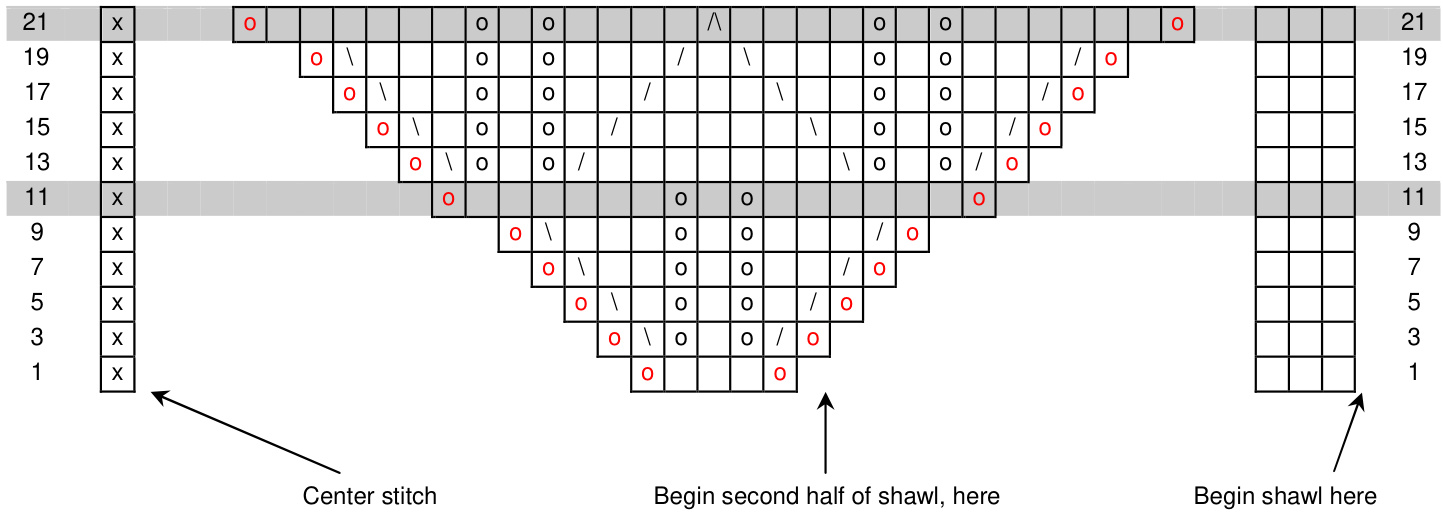
CHART 2-Kiri Pattern
Repeat rows 23-32 for lace pattern For all even rows, k3, purl to last 3 stitches, k3

CHART 3 - Kiri Edging
For all even rows, k3, purl to last 3 stitche knit Yarn over / k2tog s1, k1, psso sk2p (slip one knitwise, k2tog, psso)

Begin second half of shawl, here
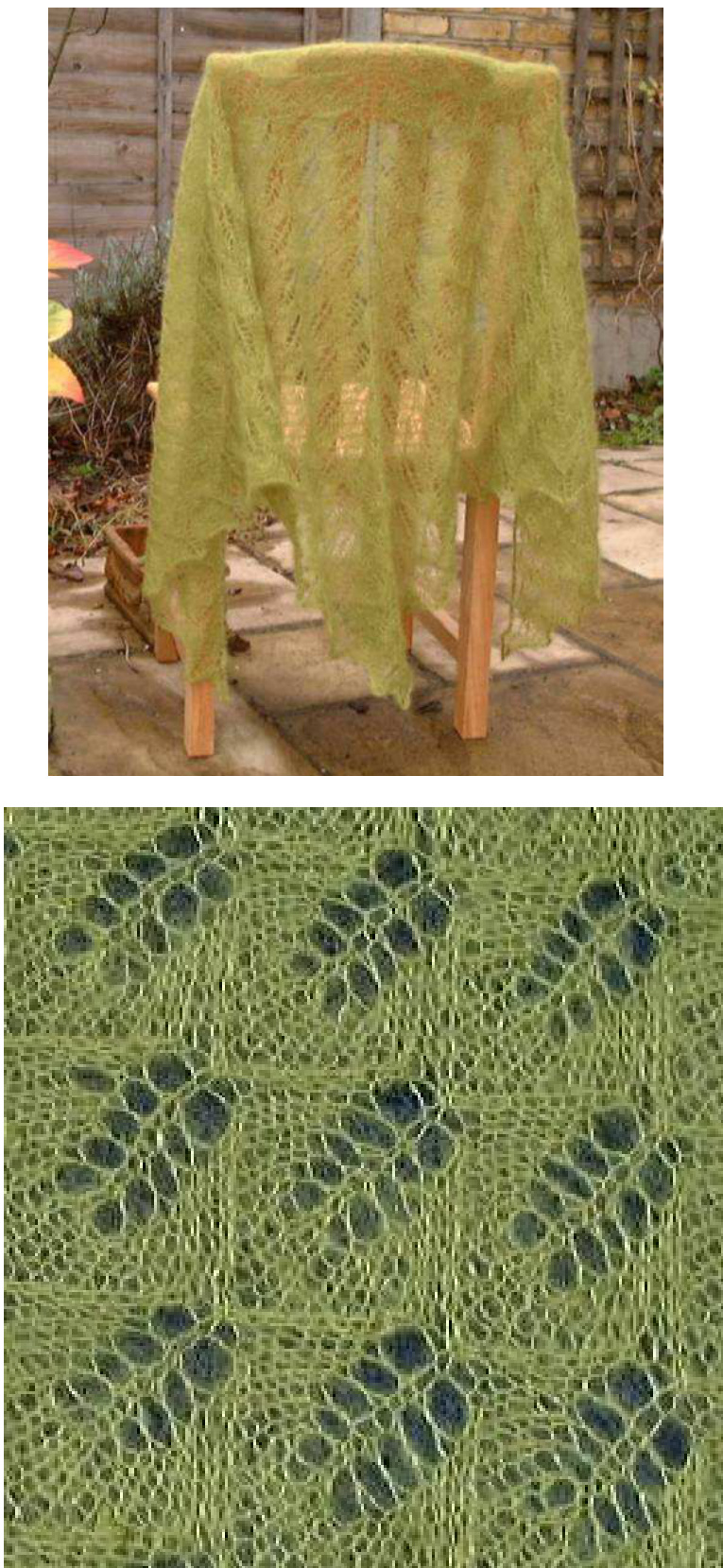
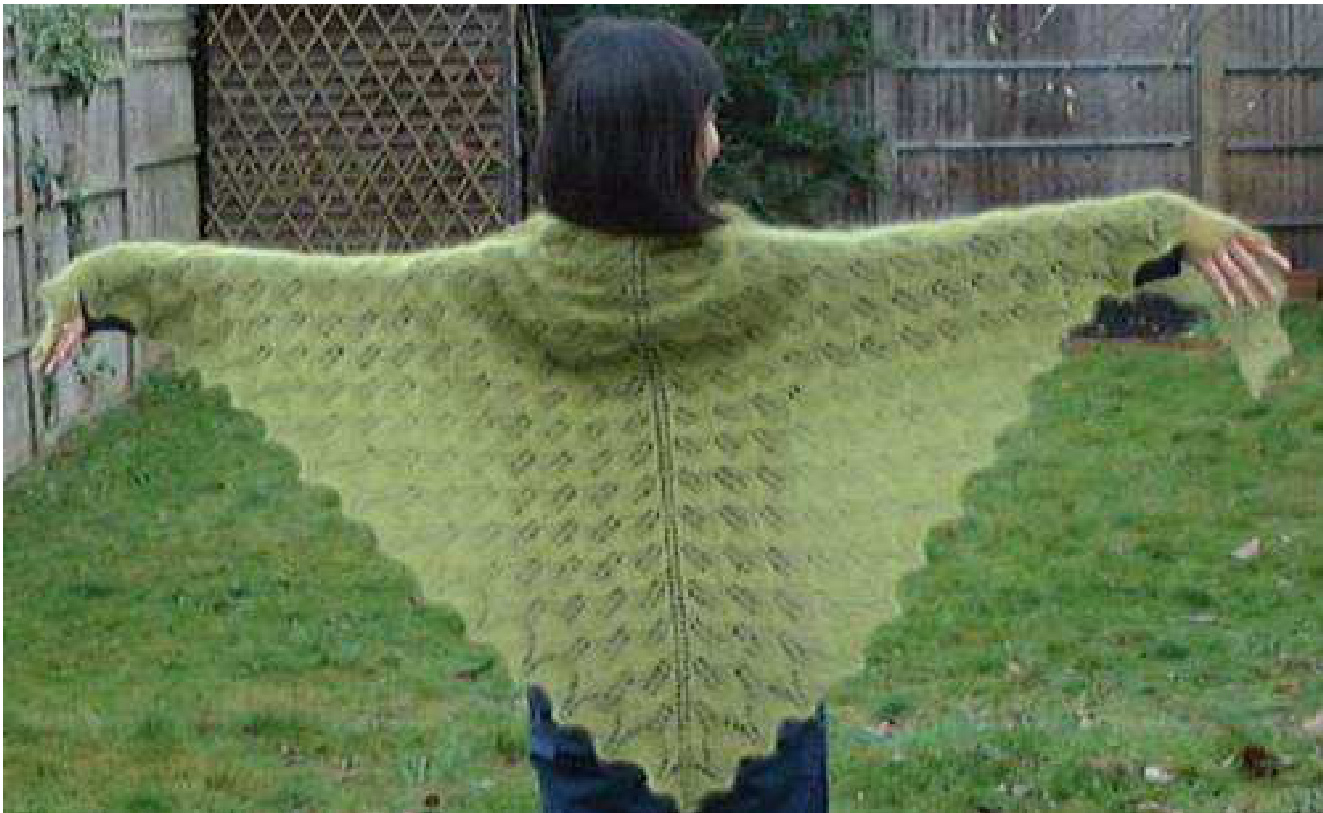
Close-up of the neck edge and the scalloped edging.
